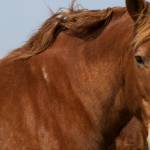Managing Equine Metabolic Syndrome

Horses with equine metabolic syndrome (EMS) generally show three signs of this disease: obesity (the whole horse looks fat, or it seems to have a reasonable body condition except for areas of fatty tissue such as a cresty neck or fat pads around the tail head); laminitis (current, history, or high risk); and insulin resistance (can be determined by a blood test). Both diet and exercise are included in a management plan for horses with EMS.
Horses that are obese and have insulin resistance do not need to be given concentrates, as these feeds are loaded with carbohydrates. They should be supplemented with a vitamin-mineral product as well as 1,000 IU of vitamin E if they are not consuming fresh forage. Hay should be the major dietary component, preferably with a nonstructural carbohydrate content of less than 10%. If hay analysis shows a higher nonstructural carbohydrate content, the hay can be soaked in cold water for 30 minutes prior to feeding to remove some of the sugar. These horses can be allowed to graze on a limited basis, but should be watched very carefully for signs of laminitis related to consumption of sugars in grass. Grazing muzzles and drylots can be used to allow the horse to exercise freely while limiting carbohydrate consumption. An exercise program needs to be planned on an individual basis for each horse. Beginning with short periods of easy work, exercise should be increased gradually as the horse can tolerate it. Daily exercise and limited dietary intake should help to control weight and decrease insulin resistance.
Some horses with EMS do not appear particularly obese, but have cresty necks and other regional adiposity. They may even be a bit thin, requiring concentrates to maintain body condition. High-sugar sweet feeds are not recommended for these horses, but they can be fed low-carbohydrate feeds. Many of these supply energy through the inclusion of super fibers (beet pulp and soy hulls), fats, and oils (rice bran and vegetable oil are common ingredients). These horses also benefit from exercise, but must be fed more calories if they perform at a high level.
Horses with acute laminitis need to be taken off pasture and concentrates. They do best on grass hay with a low carbohydrate content as well as a vitamin-mineral supplement. Hay should be provided at 1.5% to 2% of the horse’s body weight daily. During the acute phase, laminitic horses will usually be unable to exercise, but as laminitis subsides, they can often take up an exercise program, especially if therapeutic shoeing has been done.








